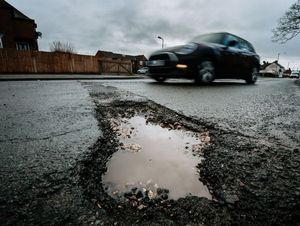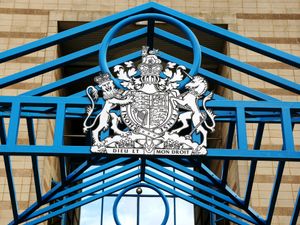Staffordshire residents among least satisfied with state of local roads
Staffordshire has been included in a list of areas where public satisfaction over how often potholes are dealt with are at their lowest.
Watch more of our videos on ShotsTV.com
and on Freeview 262 or Freely 565
Only six per cent of people in the county are happy with road repairs, putting it in the bottom 10 in England.
The AA, which has analysed the survey, said satisfaction is no better than 10 per cent in more than a third of English council areas.
The AA described the figures as "dismal" and called for an end to the "vicious cycle" of potholes being patched up only to reappear.
It analysed the latest results of an annual survey of more than 71,000 people conducted for the National Highways and Transport Network - a performance research organisation not related to Government-owned National Highways - in the early part of the summer.
Respondents were asked if the number of potholes and damaged roads in their local area was better, worse or stable compared with a year earlier.
The average satisfaction score for residents in 36 of the 96 local authority areas which participated was no more than 10 per cent.
This includes councils covering areas such as Staffordshire (six per cent), Essex (seven per cent), Lancashire (seven per cent) and Devon (eight per cent).
Three councils, which cover Herefordshire, East Sussex and Nottinghamshire, received the lowest score of five per cent.

At the other end of the scale, eight council areas achieved a score of at least 20 per cent, such as Luton (24 per cent), Manchester (24 per cent) and Southwark, central London (35 per cent).
AA president Edmund King said: "Public satisfaction with the condition of local roads is at rock-bottom in too many places. Approval scores for changes in road conditions are dismal, even though we applaud those councils courageous enough to take part in the survey and be scrutinised.”
"It has to be a priority to find out why large sums of money in grants and Government funds are failing to change public opinion.
"We often have a vicious circle of: pothole formed, damage caused, pothole patched, pothole reappears with more damage caused."
A senior civil servant told MPs last week that there is a difference between what the Government's local road condition statistics show and public perception.
Dame Bernadette Kelly , Permanent Secretary at the Department for Transport , said official figures suggest the situation is "stable" but acknowledged there is "a gap between our headline position and what most people's experience of local roads looks and feels like".
She told the Public Accounts Committee the Government has introduced a new standard for councils to report the condition of their roads, which means there are five possible ratings rather than three.
Local authorities are also being encouraged to use new technologies to ensure the data they gather is more detailed and robust.
Mr King welcomed the new reporting system but expressed concern that the bedding-in process will take until 2027.
He said: "The pothole scourge needs sorting out now, with Government grants targeted efficiently and effectively."
The cost of bringing pothole-plagued local roads in England and Wales up to scratch has been estimated at £16.3 billion.
Chancellor Rachel Reeves announced in her Budget last month that the Government will aim to fund work to fix an additional one million potholes in the 2024/25 financial year by increasing local roads maintenance funding in England by £500 million to nearly £1.6 billion.
Adam Hug , transport spokesperson for the Local Government Association , said: "Many factors affect repair rates, from the type of road and traffic levels, to inflation and ongoing pressures from other council services.
"The extra £500 million announced in the Budget for local roads will help, although greater long-term investment is needed if we are to reduce the £16.3 billion repair backlog.
"Councils' highways departments also need five-yearly funding allocations, on a par with National Highways, to give them more certainty to develop resurfacing programmes.
"The upcoming Spending Review provides an opportunity to give councils greater, longer-term funding certainty."
A Department for Transport spokesperson said: "For too long, this country has suffered from a pothole plague, which is why we're investing a further £500 million in local highways maintenance funding next year, going beyond our original commitment to support local leaders to fix up to a million more potholes annually.
"We want to achieve this in the most cost-efficient way for the taxpayer by providing local authorities with multi-year funding settlements, enabling them to better maintain their roads and avoid potholes in the first place."
The survey was conducted by research company Ipsos .
These are the 36 council areas which achieved satisfaction scores of no more than 10 per cent (score in brackets)
Blackburn with Darwen (10 per cent)
Blackpool (9 per cent)
Brighton and Hove (10 per cent)
Bury (8 per cent)
Calderdale (10 per cent)
Cambridgeshire (7 per cent)
Cumberland (9 per cent)
Derbyshire (6 per cent)
Devon (8 per cent)
East Sussex (5 per cent)
Essex (7 per cent)
Gloucestershire (10 per cent)
Hampshire (7 per cent)
Herefordshire (5 per cent)
Kent (9 per cent)
Kirklees (9 per cent)
Lancashire (7 per cent)
Medway (9 per cent)
Middlesbrough (7 per cent)
North Somerset (10 per cent)
North Yorkshire (9 per cent)
Nottinghamshire (5 per cent)
Plymouth (9 per cent)
Redcar and Cleveland (9 per cent)
Shropshire (6 per cent)
Somerset (9 per cent)
South Gloucestershire (9 per cent)
South Tyneside (10 per cent)
Staffordshire (6 per cent)
Stockton-on-Tees (10 per cent)
Torbay (7 per cent)
Trafford (10 per cent)
West Northamptonshire (7 per cent)
West Sussex (6 per cent)
Wigan (7 per cent)
Wiltshire (9 per cent)





